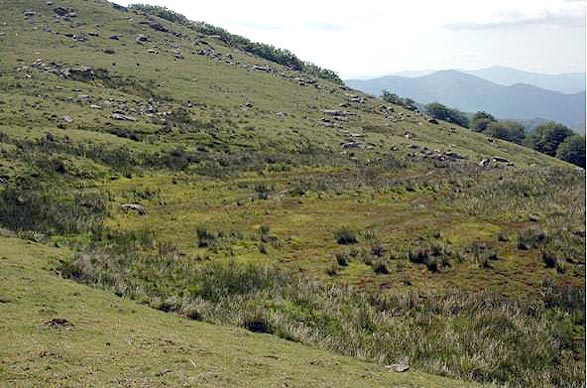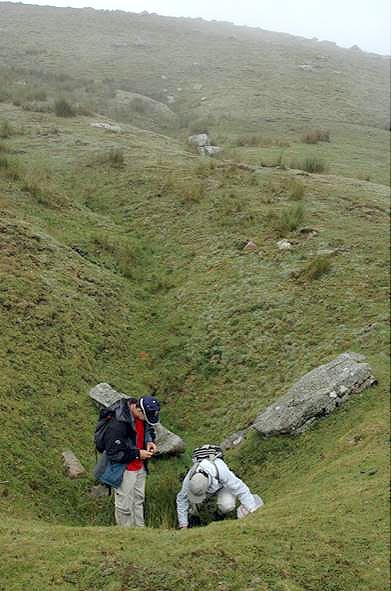Enclave Name: Argintzu
Protection Categories: ZEC Monte Alduide
Location: Baztan
Region: Navarra
Reference Coordinate: XN2368 XN 2369
See PDF map

The site is divided into several areas:
A / Acidophilus pasture surrounding the flooded areas with dry soil but with good coverage of bryophytes and sometimes Juncus squarrosus populations .
B / Shallow riverbeds, with more or less active upwelling, leading to discontinuous flows which gather in sinkholes at the height of the hill (subneutrophilus swamps ) .
C / Principal platform: Flat stream source, lined with sphagnum, quite heterogeneous from the slope of the top edge to the irrigation channel outlet ( subneutrophious to acidophilus swamps ). Note the presence of Menyanthes trifoliata.
D / Basophilus swamps, waterlogged soils with slow movement of water in the form of fans , with the presence of Palustriella falcata.
E / Small stream area with Philonotis fontana and Sphagnum teres (subneutrophilus to basophilus swamp)
F / Colluvium area with blocks cemented by clay where the streams that come out of zone D run and disappear.
The site has great heterogeneity in terms of water chemistry, with upwellings of eutrophic character and others of mesotrophic character.
- MORE RELEVANT VALUES
Singularity
Argintzu is the studied enclave with the largest range of swamp typologies, including acidophilus to basophils.Biologic and Ecologic Features
Regarding the vascular flora, the presence of Menyanthes trifoliata must be noted. Among the bryophytes, Sphagnum teres is new to the bryologic catalog of Navarra, and the population of Scorpidium cossonii, the second located in Navarra.Historic and Paleo-ecologic Features
No peat depositHabitats of Community Interest
Habitat Nombre 4030 Brezales secos europeos 6230 Formaciones herbosas con Nardus, con numerosas especies, sobre sustratos silíceos de zonas montañosas (y de zonas submontañosas de la Europa continental) 6410 Prados con molinias sobre sustratos calcáreos, turbosos o arcillo-limónicos (Molinion caeruleae) 7140 «Mires» de transición Habitats According to Other Classifications
Habitat CINH Sintaxón 4030 303044 Erico tetralicis-Ulicetum gallii ulicetosum gallii var. Típica 6230* 523010* Carici piluliferae-Agrostietum curtisii nardetosum strictae 6230* 523013 Serratulo tinctoriae-Nardetum strictae 6410 541030* Com. Juncus effusus y Scutellaria minor 7140 211012 Hyperico elodis-Potametum oblongi 7140 622010* Com. Palustriella falcata 7140 622010* Com. Philonotis fontana y Bryum pseudotriquetrum 7140 613010* Erico tetralicis-Sphagnetum papillosi 7140 617011 Anagallido tenellae-Juncetum bulbosi 7140 617010* Com. Sphagnum auriculatum y Narthecium ossifragum var. típica 7140 723010* Com. Sedum anglicum y Rumex angiocarpus Flora
Argintzu is an enclave fairly typical floristically in the context of the Eastern Basque para-peatland environments, because there are plenty of the species most common to thses environments. Only the presence of a population of Menyanthes trifoliata is notable, on the other hand quite harvested. We can also mention that Huperzia selago has been cited in the peak area (Balda 2002: 163).69 vasculares and 33 brophytes have been detected. Among the bryophytes the presence of two species with continental tendency, more frequent towards the East, Central Pyrenees: Sphagnum teres and Scorpidium cossonii are noted.
- PHOTOS

General aspect of zone C, to the right the emergence of zone E is apprciated (P. Heras).

General aspect of zone C. (P. Heras).

Dolina on the upper part of the enclave (Zone B). (P. Heras).


